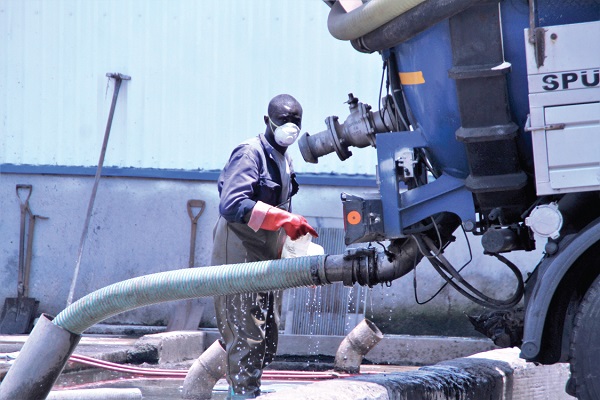
There is a new Lavender Hill
The new faecal waste treatment plant, which replaced the closed Lavender Hill, has so far been in operation for three years and is gradually removing the stigma and shame that came with the derisive name.
A tour of the twin waste facilities sharing the same location – the Lavender Hill Faecal Waste Treatment Plant and the rehabilitated Mudor Waste Water Treatment Plant- shows that the country is now applying globally accepted hygienic ways of treating its liquid waste.
Advertisement
At the time the Daily Graphic visited the new Lavender Hill, cesspit emptiers, owned by mostly individuals and some assemblies, were arriving every 10 minutes to empty their contents hygienically in a safe environment through pipes into the waste receptacles of the plant.
The receiving bay of the plant takes a maximum of eight trucks at a time and it takes not more than 10 minutes to empty and clean the trucks with water that is provided, and it is all done by workers properly attired in their overalls, nose masks, boots and gloves unlike what persisted in the old order.
Totally decommissioned
The General Manager of the plants, Mrs Florence Cobbold, told the Daily Graphic that all cesspit emptiers in Accra and even beyond now disposed of their contents at the facility and that the old dumpsite had been totally decommissioned so trucks were no more dumping there. A visit to the old site confirmed that the old Lavender Hill was gone for good.
While heaps of sand and a barricade were on site to prevent any illegal dumping, it was noticed that the drivers had parked their trucks along the street and waiting under a shed, ostensibly for calls from potential clients.
In an interview with the Business Development and Communications Manager of Sewerage Systems Ghana Limited, Mrs Lola Asiseh Ashitey, said the company was building its fourth 1,000 cubic metres waste treatment plant in Kumasi at an estimated cost of €13 million, which, she said, would be completed by August 2020 after which they would move to Takoradi and Tamale. “We currently have two faecal treatment plants and one waste water treatment plant,” she stated.
Background
For several decades, Ghana dumped liquid waste directly into the sea.
Lavender Hill became the name given to the notorious human excreta dumping site because of the stench that engulfed the entire area where the cesspit trucks emptied their cargo into the sea at Korle Gonno in Accra.
The government, in a public private partnership (PPP) with Sewerage Systems Ghana Limited, built a new faecal waste treatment plant at Jamestown, just few metres from the infamous dumpsite.
The plant, which was completed and commissioned in November, 2016 enabled the Accra Metropolitan Assembly (AMA) to decommission the decrepit Lavender Hill dumpsite.
Mudor plant
Mrs Ashitey told the Daily Graphic that the Mudor Waste Water Treatment Plant was connected to the very few sewer networks in the country which could be found in some parts of Accra such as Cantonments, Dansoman, Highstreet, Ministries and Legon, where there were underground pipelines laid to send waste water from kitchens, bathroom and water closets to the facility for treatment and reuse or disposal.
“Here in Ghana because we do not have sewage systems, people resort to containment and that is how come we have manholes in our homes,” she explained, adding : “These are structures we should have had a long time ago. If we want to have that now it means we have to break into people’s homes.”
Mrs Ashitey stated that: “Only five per cent of Ghana is sewered and that includes Tema, some parts of Accra, some institutions such as Legon, and then the only city that is heavily sewered is Akosombo and that was done by the Volta River Authority.”
Working system
During the tour of the Mudor Plant it was noticed that the entire system was running with workers and engineers going about their duties.
Almost all the 21 drying beds of the facility were filled with the by-products of the treatment process, which Mrs Ashitey explained, would either be used for compost or bio char (charcoal from liquid waste).
Cattle egrets were lined up in a parade on one of the beds as if to say that they appreciated the cleanliness, orderliness and work that was ongoing at the two treatment plants.
The Process Engineer of the plants, Ms Elsie Nana Esi Ekumah, who showed the Daily Graphic around, said treatment of the waste was done with a combination of physical, biological and chemical processes.
Explaining the important role of the two plants, she said because the country had resorted to containment, there was a certain value chain that must be charted from depositing to emptying, transportation, treatment and then reuse.



